Brazil Nut
The Brazil nut is commonly grown in various parts of South America. It belongs to the family “Lecythidaceae”. The name Brazil nut refers to both the tree as well as the edible nut derived from it.
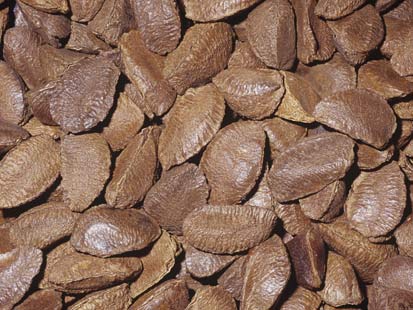
Brazil Nut
Table Of Content
Brazil nut Scientific Name
The scientific name for this tree is “Bertholletia excelsa”.
Brazil nut Description
The Brazil nut tree is one of the largest trees in the rainforests of Amazon. It is a deciduous tree reaching a height of nearly 160 feet or more. The crown spreads for more than 100 feet in diameter. The diameter of the trunk is normally less than 6.6 feet but in some cases, trees having a trunk diameter of 10 feet have been found. The stem of the tree is straight and un-branched on the lower half. The tree bark is smooth and grayish. The trees can live anywhere from 500 to 1000 years.
The oblong-shaped simple leaves are alternately arranged. They have a length of 20-35 centimeters and a breadth of 10-15 centimeters.
The small flowers are greenish-white in color. Flowers are arranged in 5 to 10 centimeters long panicles. Each flower is comprised of a two-parted calyx, six cream-colored petals of unequal size and several stamens joined together to form a hood shaped mass.
The fruits of this tree are spherical pods with a hard covering. The pods are anywhere between 3 to 7 inches in diameter and resemble coconuts. The fruits can attain a weight of up to 5 pounds. A mature tree can carry for more than 300 pod-like fruits.
Around 10 to 40 seeds or nuts are arranged like orange segments inside the woody, hard exterior of the fruits. The nuts are 3 to 5 cm in length, have three sides and are covered by a hard shell. Inside the shell, a brown seed coating covers a white seed kernel. Oil can be extracted from these seeds. Antioxidants are present in the brown seed coat which protects the seed from oxidative rancidity resulting from atmospheric oxygen.
The root system of the tree is very long and extensive, which has resulted in the absorption of some minute quantities of radium from the soil.
Brazil nut Cultivation
Brazil nut trees grow mostly in the moist lowlands of Amazonian rainforest. These trees can be grown from the germination of the seeds. Firstly, it has to be made sure that the seeds collected for germination are raw. A lot of the seeds available in the market are soaked and boiled. This kills the seeds’ ability to sprout. The seeds should be harvested directly from the wild; only then the seeds will be able to sprout.
The seeds should be soaked well with water. This allows softening of the outer skin of the seed and gives the nut some time to sprout. A large mason jar should be filled one third with water and the nuts covered in husk should be soaked in them. This should be left covered for 24 hours. After that, the water should be poured out and the seeds should be rinsed. This process should be repeated several times and the time duration for soaking should be gradually reduced to 8 hours. The outer husk covering of the nut should be removed after sprouting starts to appear.
The Brazil nuts require certain specific conditions for optimum growth. In order to achieve such conditions, the planting environment should be prepared like a rain forest. A large-sized canning jar should be filled two third with water-soaked potting soil rich in nutrients. After planting the sprout, the jar should be covered using cheesecloth and a rubber band.
The seed should be planted on the ground by cutting a depression in the soil. This depression should have enough space for covering the entire seed. The seed should be covered with soil and moderately watered. Care should be taken to avoid water logging and the growth of moss and peat. The covered and tied jar should then be placed in a place with indirect or low sunlight.
The germination process should be closely monitored. After germination, the jar should be moved to a more sunny location. The cheesecloth should be removed periodically on a regular basis for a few hours. This will enable the plant to enjoy some fresh air. The tree should be watered as per need. When the tree has developed a set of true leaves, it should be moved to a larger pot. This will provide the tree with more space to grow.
The Brazil nut tree depends on certain animal species and other plants for its healthy growth. The rodent agoutis helps in dispersal of seeds and bees help in the pollination of flowers. Disappearance of these other species will also lead to annihilation of the Brazil nut tree population.
Brazil nut Harvesting
Brazil nuts are harvested from the months of December to June. During these times, the pods or nuts ripen and fall from the trees. The harvesters extract the seeds from the nuts, dry them and then wash them. The seeds have their hard covering intact when they are brought to the market.
Brazil nut Nutritional Facts
For 100 grams of Brazil nuts, the nutritional facts are given below:
| Energy | 2,743 kJ (656 kcal) |
| Water | 3.48 g |
| Sugars | 2.33 g |
| Starch | 0.25 g |
| Dietary fiber | 7.5 g |
| Fat | 66.43 g |
| Protein | 14.32 g |
| Threonine | 0.362 g |
| Tryptophan | 0.141 g |
| Leucine | 1.155 g |
| Isoleucine | 0.516 g |
| Methionine | 1.008 g |
| Lysine | 0.492 g |
| Phenylalanine | 0.630 g |
| Cystine | 0.367 g |
| Valine | 0.756 g |
| Tyrosine | 0.420 g |
| Histidine | 0.386 g |
| Arginine | 2.148 g |
| Aspartic acid | 1.346 g |
| Alanine | 0.577 g |
| Glycine | 0.718 g |
| Glutamic acid | 3.147 g |
| Serine | 0.683 g |
| Proline | 0.657 g |
| Carbohydrates | 12.27 g |
| Folate (Vitamin B9) | 22 μg (6%) |
| Vitamin B6 | 0.101 mg (8%) |
| Niacin (Vitamin B3) | 0.295 mg (2%) |
| Riboflavin (Vitamin B2) | 0.035 mg (3%) |
| Thiamine (Vitamin B1) | 0.617 mg (54%) |
| Vitamin E | 5.73 mg (38%) |
| Vitamin C | 0.7 mg (1%) |
| Iron | 2.43 mg (19%) |
| Calcium | 160 mg (16%) |
| Manganese | 1.223 mg (58%) |
| Magnesium | 376 mg (106%) |
| Potassium | 659 mg (14%) |
| Phosphorus | 725 mg (104%) |
| Sodium | 3 mg (0%) |
| Zinc | 4.06 mg (43%) |
Brazil nut Distribution
These trees are grown in various parts of South America, such as Brazil, Bolivia, Colombia, Ecuador, Venezuela and Peru.
Brazil nut Edible Usage
Here are some common ways of consuming these nuts.
- These nuts can be consumed raw or they can be roasted, sweetened or salted.
- Brazil nuts are also used in food preparations such as puddings, fudge, pesto, crunch bars and chocolates-bars.
- These nuts can be roughly grounded and added to salads.
- Brazil nuts are used in preparing desserts like fruit cakes.
- They can be added to vegetarian and non-vegetarian dishes as well as soups.
- Brazil nut oil is used as cooking oil.
Brazil nut Health Benefits
Consumption of Brazil nuts can be beneficial to human health in the following ways:
- Brazil nuts have high quantities of mono-saturated fatty acids such as oleic acid and palmitoleic acid which helps in combating heart diseases like strokes and coronary artery disease. The abundant presence of fatty acids contributes to Brazil nut’s high level of caloric content. This helps in reducing bad cholesterol or LDL and increase good cholesterol or HDL in the blood.
- Brazil nuts are rich in selenium. Selenium is a significant cofactor for anti-oxidant enzyme glutathione peroxidase. Just eating a few nuts everyday will help in prevention of diseases like liver cirrhosis, coronary artery disease and cancers.
- These nuts also have ample amounts of Vitamin E. Vitamin E is a powerful lipid soluble antioxidant which protects the cell membrane of skin and mucus membranes from potentially dangerous oxygen free radicals.
- Brazil nuts contain several minerals such as magnesium, copper, manganese, calcium, phosphorus, potassium, iron and zinc. Manganese is a vital co-factor for antioxidant enzyme superoxide dismutase. Copper is a key mineral that helps in preventing osteoporosis and anemia.
- These nuts contain high proportions of B-complex Vitamins such as riboflavin, thiamin and vitamin B-6 which act as important co-factors for enzymatic reactions such as cellular substrate metabolism.
- Gluten free foods act as good alternative food source for people with celiac disease and wheat food allergy. The Brazil nuts are completely gluten free and so they are used to prepare gluten free foods.
- Consumption of Brazil nuts reduces the chances of prostate cancer and liver cancer.
Brazil nut Oil
The Brazil nut oil is yellow in color. It has a sweet fragrance and taste. The oil is extensively used as an emollient. It is also used in aromatherapy and message therapy. Messaging the oil on skin helps to avoid dryness. Brazil nut oil is also used as a cooking oil and as a base oil in the cosmetic and pharmaceutical industry.
Brazil nut Uses
Apart from its culinary uses, Brazil nuts are also used in the cosmetic industry and for the manufacturing of skin care products, soaps, hair conditioners and shampoos as well as for manufacturing artist’s paints. It is also used as a lubricating agent while making clocks.
High quality lumber can be extracted from these trees. However, cutting these trees is prohibited by the law.
Brazil nut Recipes
Brazil nuts are widely used in food preparations such as fruit cakes, ice creams and fudge, puddings and chocolates ‘n’ nuts recipes. Some of the well known recipes using these nuts as an ingredient include Brazil nut & banana crunch Saturdaes, Brazil Nut Fruitcake, Brazil Nuts pudding and Brazil Nuts covered in Dark Chocolate.
Brazil nuts Availability
Brazil nuts are available in the market as raw or roasted seeds and can be salted or sweetened. The raw nuts are available anytime between the months of January and June. The unshelled and shelled nuts are available any time of the year.
Brazil nuts Interesting Facts
Here are some interesting facts about these amazing nuts:
- The Brazil nut effect is named after these nuts. It is the tendency of comparatively large-sized items to rise to the upper levels of a mixture of variably sized different items having similar densities.
- The pods of these trees are quite heavy and weigh almost 5 pounds.
- The white kernel of the seeds has high oil content and so it can sustain a flame much like a candle.
- The rodent agoutis are the only species that can crack open the outer covering of the fruit with their sharp teeth.
- Even though these nuts are named as Brazil nuts, most quantities of these nuts actually come from Bolivia where they are known as “almendras”.
Brazil nut Side Effects
The shells of these nuts are rich in a chemical substance called aflatoxins, which increases the risk of liver cancer.
In some cases, they can also cause allergic reactions. These reactions can range from itching of the skin to more severe anaphylactic reactions such as abdominal pain, breathing problems, vomiting and diarrhea.
When these nuts are consumed in excess, it can lead to selenium toxicity. The various symptoms of selenium toxicity include vomiting, bad breath, nausea, emotional disturbances, dermatitis, alopecia or loss of hair, dental caries and neuropathic pain.
Brazil nuts During Pregnancy
It is okay to consume Brazil nuts during pregnancy unless you are allergic to it.
Brazil nut Images
Here are some images of these nuts and the trees in which they are grown.
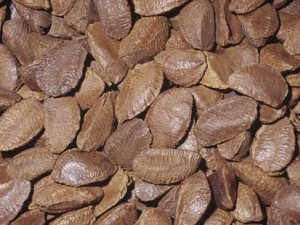 Picture 3 – Brazil nut Picture
Picture 3 – Brazil nut Picture
The Brazil nuts are one of the most nutritious nuts of all and an important source of selenium. Unfortunately, the conservation status of these trees has been declared as vulnerable by IUCN. It is thus important to preserve the population of these trees by curbing deforestation as well as providing necessary conditions for these trees to grow healthily.
References:
http://www.britannica.com/EBchecked/topic/78309/Brazil-nut
https://www.rainforest-alliance.org/species/brazil-nut-tree/
- by Prasenjit Banerjee
- January 2nd 2012

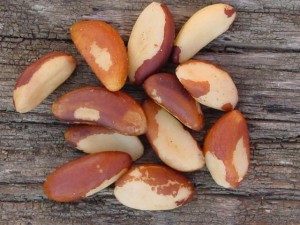
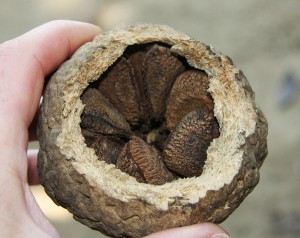
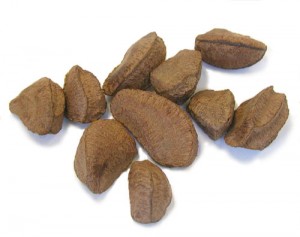
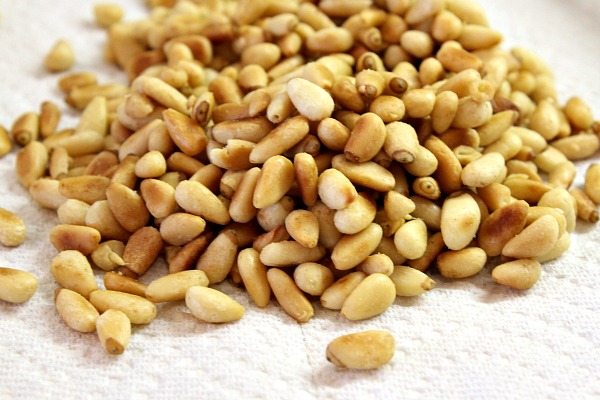

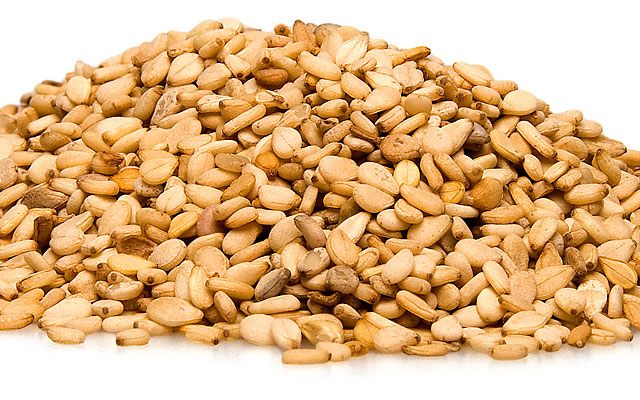
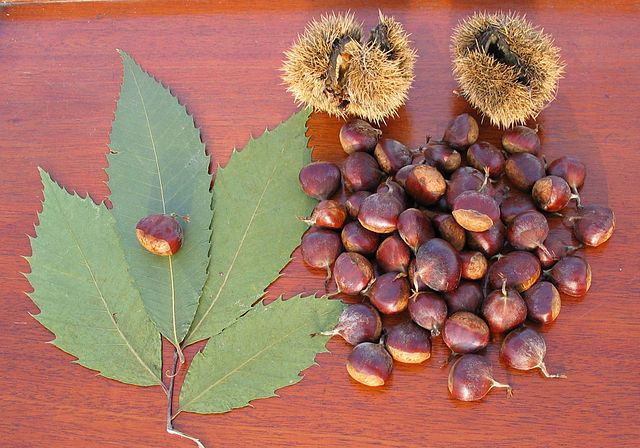















Leave a Reply